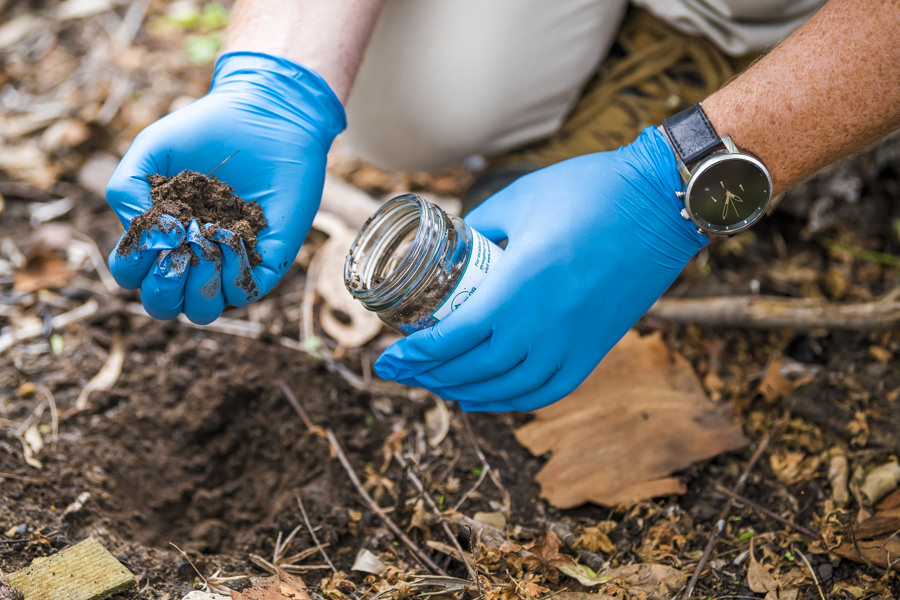Lead deposits are often found as dust in ceiling spaces, or in soil. Lead in dust or soil is often there as a result of previous refurbishment, but it can also be due to:
- Atmospheric deposits (e.g. from previous lead petrol use)
- Lead residue from nearby industrial sites (e.g. smelters)
- Other lead paint removal projects nearby
If you suspect you may have found lead in dust or soil, it’s important to have a sample tested straight away.
Find out how to collect a dust or soil sample for lead testing »
-
Lead paint presents a risk to health if it is ingested or inhaled. There is minimal risk if the condition of the paint is sound, but it can become risky when it chalks or flakes, or in places like sash windows where it is subject to frequent abrasion.
Dust from deteriorated lead paint is a recognized source of lead exposure in residential, public and commercial buildings. The peeling and flaking of lead paint may also cause dangerous residues of lead to build up in accumulated dust.
As well as depositing inside buildings, lead paint dust can settle on adjacent external soil, water, food and vegetation. Therefore, food-producing gardens, or water supplies for human or animal consumption, should not be positioned near areas of possible lead contamination.
Lead paint also presents a health risk if is disturbed by paint removal methods like sanding or burning. Even mechanical scraping of lead paint poses health risks. In fact, removing paint can be especially risky, as small particles of dust may lodge in furnishings and carpets, making detection or removal difficult.
Proposed work sites may already be contaminated with lead due to earlier, poorly controlled maintenance or repainting practices. It may be necessary to determine background levels in surrounding soil, or on interior and exterior surfaces, prior to work commencing.

-
The power to control pollution caused by lead hazards is given to councils under the Protection of the Environment Operations Act 1997. Prevention notices with required actions can be issued if a council reasonably suspects that any activity has been or is being carried on in an environmentally unsatisfactory manner.
The Work Health and Safety Regulation 2017 contains the following clauses, which can carry penalties if not carried out.
- “A person conducting a business or undertaking at a workplace must assess each lead process carried out by the business or undertaking at the workplace to determine if lead risk work is carried out in the process.”
- “A person conducting a business or undertaking at a workplace must ensure, so far as is reasonably practicable, that contamination by lead is confined to a lead process area at the workplace.”
- A person conducting a business or undertaking at a workplace must ensure that any measures implemented to control health risks from exposure to lead at the workplace are reviewed and as necessary revised.”
-
Lead deposits are often found as dust in ceiling spaces, or in soil. Lead in dust or soil is often there as a result of previous refurbishment, but it can also be due to:
- Atmospheric deposits (e.g. from previous lead petrol use)
- Lead residue from nearby industrial sites (e.g. smelters)
- Other lead paint removal projects nearby.
If you suspect you may have found lead in dust or soil, it’s important to have a sample tested straight away.
Find out how to collect a dust or soil sample for lead testing
Criteria for lead dust levels have not been established in Australia. Lead dust levels are typically compared to health investigation levels for soil contaminants as stated in the National Environment Protection (Assessment of Site Contamination) Measure 1999 (April 2013).

-
The two primary means of lead contamination in humans are breathing in dust or fumes that contain lead, and swallowing food or water that contains lead. High lead levels can cause serious long-term health problems and harm almost every part of the body, especially the brain, kidneys and reproductive organs. Lead can damage the developing brain and nervous systems of unborn children much more easily than those of adults.
Children and adults with increased levels of lead in their bodies may show no symptoms, even though their health is being affected. When symptoms do become obvious, they include lethargy, stomach pain or constipation, headaches and irritability. Children show these symptoms at lower levels of exposure than adults do.




